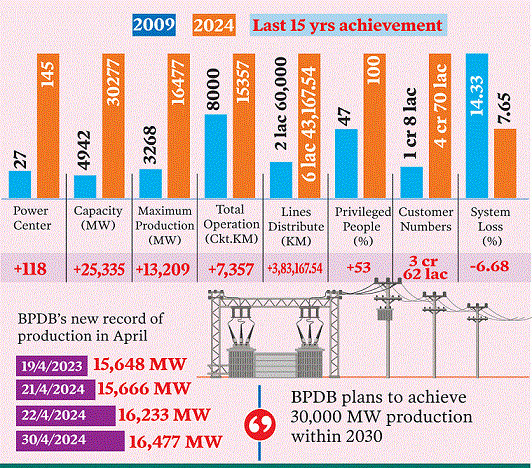The present government led by Prime Minister Sheikh Hasina, daughter of Bangabandhu, assumed state power in 2009 when the country had 47 percent electricity connection.
At that time, the country produced 4,900 megawatts of electricity. The Awami League (AL) election manifesto also included ensuring 100 percent electrification by 2021. However, due to the Corona epidemic, it was possible in the following year 2022. At present, the power generation capacity has also increased to 30 thousand 277 MW (including captive and renewable energy).
As a result, the power generation capacity has increased by 25 thousand 335 MW in the last 15 years after the present government took office. This is one of the government's greatest achievements.
According to the manifesto, illuminating every house of the country with electricity is a great achievement of Prime Minister Sheikh Hasina. And through this achievement, the socio-economic condition has improved greatly in the last 15 years, especially in the countryside. Due to 100 percent electricity connection and increase in power generation capacity, today the people of the village have become self-reliant.
State Minister for Power, Energy and Mineral Resources Nasrul Hamid recently told parliament that the country's power generation capacity is more than the demand. Because, after assuming office in 2009, the present government has been implementing immediate, short, medium and long-term plans for the development of the power sector through intensive supervision. From January 2009 to present, 26 thousand 240 MW electricity has been added to the national grid. As a result, the installed capacity of electricity has been increased to 30 thousand 277 MW including captive.
Although there is no shortage of power generation capacity as per the demand, it is not possible to produce electricity at full capacity due to the Ukraine-Russia war and global energy crisis after the Covid-19 epidemic. As a consequence, there is temporary difficulty in uninterrupted power supply in some places. Besides, the demand for electricity has increased due to excessive heat and heat wave in some parts of the country. Emphasis is also being placed on increasing production as demand increases. We will be able to provide uninterrupted and quality electricity facilities soon.
Meanwhile, the Bangladesh Power Development Board (BPDB) has set a new milestone of highest power generation on April 30, 2024 in the history of the country. The company has set a unique record of maximum power generation three times in a month. Of these, the highest power generation was recorded at 16,477 MW at 9 pm on April 30. As a result, a new record has been set in power generation in the country's 54-year history.
This is the result of BPDB's relentless work to produce uninterrupted power to maintain comfort in the public life during the last heatwave. On April 22, the record of power generation was 16,233 MW at 9 pm. Earlier, the highest power generation record was 15,666 MW at 9 pm on April 21. Last year, the record was 16,648 MW on April 19.
Several officials of the BPDB said that the power supply was uninterrupted even during the heat wave under the overall and round-the-clock supervision of the current chairman Mahbubur Rahman. As a result, it has been possible to set a record of generating electricity three times in a month in the heat wave.
They also said that the people of the country may face another heatwave. Although the impending heat wave is only the prediction of the Meteorological Department, we hope that there will be no such effect. Since we have already faced the maximum heat wave, we will be able to face the upcoming low intensity heat wave successfully. Moreover, the chairman of BPDB has also made plans for the upcoming heatwave. They said that since electricity is the prerequisite for development, the chairman of BPDB is now taking and implementing various plans to achieve the desired target of generating 30,000 MW of electricity by 2030.
About the comparative progress of the power sector after the present government assumed power in 2009, BPDB sources told The Daily Post that at that time the number of power plants in the country was only 27. At present, the number of these centers has increased to 145. That is, in the last 15 years, more than 118 power plants have increased. Maximum power generation (6 January 2009) was 3,268 MW, at present (as of 30 April 2024) 16 thousand 477 MW. In the last 15 years, it has increased to more than 13,209 MW. The total transmission line was 8,000 circle km; at present, 15,457 circle km. In the last fifteen years, it has increased by more than 7,357 circle km. The grid substation capacity was 15,870 MVA, now 68,564 MVA. That's an increase of 52,694 MVA in 15 years. At that time, electricity import was in zero quota, now 2,656 MW electricity is being imported. The electrified distribution lines were 260,000 km, currently (as of 30 June 2023) 643,167.54 km.
In fifteen years, it has increased by more than 3,83,167.54 km. The number of people with access to electricity was 47 percent, now this number is 100 percent. Per capita power generation was 220 kWh, currently 602 kWh, including captive and renewable energy (up to 2022-2023 fiscal year). Per capita production has increased by 382 kWh in fifteen years. The number of electricity consumers was 10.8 million, now it is 47 million. In fifteen years, subscribers have increased by 3 crore 62 lakh. The number of irrigation connections was 2 lakh 34 thousand, now 4 lakh 87 thousand. In fifteen years, this number has increased by 253,000. The distribution system loss was 14.33 percent in 2008-09, which has come down to 7.65 percent in 2022-23. In the last 15 years, it has decreased by 6.68 percent.
Regarding increasing the quality of power service, State Minister Nasrul Hamid said that the construction of underground lines and underground substations in the metropolitan and other areas of the country is underway for the safety of the people, modernization of the power system and proper and quality power supply. About 2,770 kilometers of underground lines have already been completed. Activities have been taken to set up 855 km and 250 km underground distribution lines in DPDC and DESCO areas respectively by 2025. He hopes that after these activities to increase the quality of service, the problem of hanging wires in the power distribution lines will also be resolved.
ZH






